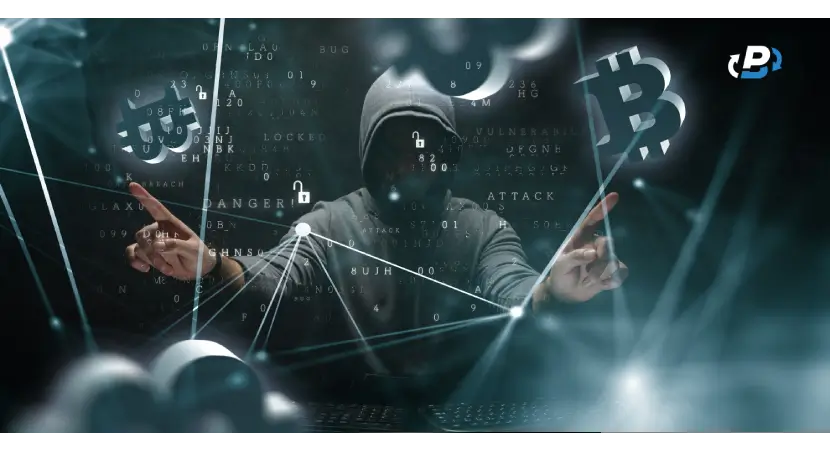As long as there’ve been markets, there’ve been underground ones where shady characters sell illicit goods ranging from fissile materials, weapons, and nefarious tools to body parts, opioids, personal information, and company secrets. These cryptic places offer cloak-and-dagger services too, though the reliability of available freelancers varies significantly due to the lack of a verifiable track record. They exist on the internet as well under the name “dark web vendors” and avoid fiat currencies because they are traceable, so what crypto is used on the dark web? Bitcoin is still the main dark web payment method, even though it’s easily traceable, because it is the oldest and the most popular coin, Monero is in close second place because it is an untraceable privacy coin, meaning the identities of the buyer and the seller and the amount transacted are completely hidden.
Other privacy coins, such as Beam, Verge, and Zcash, have gained popularity as payment methods on the dark web for the same reasons as Monero. As the throughput and versatility of dark web markets increased, so did the law enforcement agencies’ desire and capability to monitor them through the analysis of various cryptos and decryption of how their transactions work. Bitcoin used to be a privacy coin all the way up to the late 2000s, when financial investigators developed and deployed crypto transaction analysis tools that allowed them to track and identify vendors and buyers on dark web markets. Today, Bitcoin’s supremacy on the dark web is jeopardized by Monero, a far more private method of sending and receiving money. Here is a timeline of how dark web markets appeared and evolved alongside Bitcoin, Monero, and other convenient and private cryptocurrencies.
The Dark Web Explained
Shady markets were always vulnerable to sabotage because any leaked information, such as locations, identities, or goods sold, could attract unwanted attention from competitors and busybodies. Market organizers and sellers of illicit goods had to sleep with one eye open, gripping their pillows tight, and their hearts skipping a beat whenever they heard a knock on the door and not knowing if it’s an assassin or a buyer. With the appearance of the internet and the dark web, which became a network of gathering places for vendors selling illicit goods. These shady markets moved online, giving everyone involved more privacy and a greater reach. Early dark web markets were primitive and local; they functioned more like message boards for people who weren’t afraid to meet up in person and pay for illicit goods in cash. That all changed with the arrival of Bitcoin, when people realized they could exchange money through cryptocurrencies and do it online. Nobody even thought of making a global marketplace that would sell illicit goods for Bitcoin while keeping everyone's identities hidden until Silk Road appeared.

Silk Road and the Rise of BTC
In 2011 in the USA, there was a guy with a dream — he wanted to create a dark web marketplace and sell psychedelic mushrooms through it. His name was Ross Ulbricht, and he will go down in history as the creator, owner, and operator of Silk Road, the first modern dark web market. Ross built Silk Road from scratch, including the payment processor, which was his first mistake, because it had many bugs that cost Ross thousands of dollars a day and many thousands of Bitcoin. At first, he only wanted to make some money on the side, but when Silk Road became hugely popular, he wrote in his diary that Silk Road can become “a brand that people can come to trust and rally behind. Silk Road chat, Silk Road exchange, Silk Road credit union, Silk Road market, Silk Road everything!” The Silk Road brand will not manifest, because Silk Road was shut down in October 2013, with Ross Ulbricht arrested for a myriad of crimes, including hiring an assassin to get rid of people who started blackmailing him. Ross Ulbricht got two life sentences without parole plus 40 years, but others will build on Ross’ legacy.
Silk Road used this quirky new way of paying called Bitcoin that let buyers pay for illicit goods and services without revealing their personal information. It sounded too good to be true — you didn’t have to have a bank account or explain where and how you got the funds. All you needed was an internet connection and a Bitcoin wallet, and you could pay anyone for anything, seemingly anonymously. In three years, the site moved 9 million Bitcoin in sales. Today, when we ask ourselves what crypto is used on the dark web, we know that Bitcoin has several major flaws, the most important of which is that it’s not anonymous at all. The movement of Bitcoin can be traced across decades and hundreds of wallets to identify whose it was, with the Bitcoin blockchain serving as a reliable, public, and indestructible record of transactions and transacting parties. Using Bitcoin is not illegal, but every Bitcoin transfer leaves behind a breadcrumb trail that leads back to the original owner. If that owner did something illegal with that Bitcoin, it becomes tainted and taints every wallet it touches, potentially landing every subsequent owner of it in trouble.
Is Bitcoin Used on the Dark Web?
In the same way a chain is only as strong as its weakest link, anonymity in cryptocurrency transactions only exists as long as all parties are equally protected. As soon as one sender or recipient is de-anonymized, the entire chain of senders and recipients becomes compromised. If law enforcement agencies can arrest one Bitcoin user and get him to confess to his transactions, they can unravel the entire network and identify everyone. So, is Bitcoin used on the dark web? Yes, people still use it because they don’t know it’s easily traceable, and it’s the most popular crypto out here. Some vendors “solve” the problem with Bitcoin mixers that mask the origin of the tainted Bitcoin , but law enforcement agencies have found way to trace these transactions as well.
The Rise of Privacy Coins
There is no permanent solution to Bitcoin’s privacy problems, because Bitcoin’s blockchain is both the source of its strength and its greatest privacy weakness, this makes Bitcoin a wrong answer to the question of what crypto is used on the dark web. All Bitcoin transactions being recorded on the blockchain and the blockchain being public does mean that nobody can tamper with Bitcoin, but it also means that it’s difficult to hide Bitcoin wealth, especially that gotten through crime, and nearly impossible to cash it out without being traced. That happened to Jimmy Zhong, who was one of the people who realized that Silk Road was coded from scratch by an amateur. Jimmy discovered a bug in the Silk Road payment processor that allowed him to withdraw his deposit many times. Ross made the rookie mistake of programming the payment processor so that it doesn’t account for congestion and doesn’t have a mandatory cooldown on successive withdrawals by the same user.
By quickly clicking the “Withdraw funds” button, Jimmy could go negative on his account balance, essentially stealing Ross’ Bitcoin. When his account got suspended, Jimmy made a new one and kept repeating the trick, drawing over 51,000 BTC from Silk Road. He used crypto mixers to move it around, living a decadent life and telling his friends that it’s due to having mined a lot of Bitcoin during its inception. His cocaine habit eventually got to him, and he got sloppy, withdrawing his BTC through an exchange with KYC and also getting arrested for cocaine possession. After the cops looked into him and started tracing his Bitcoin, they realized Jimmy was one of the Silk Road hackers. He pled guilty, forfeited his 50,000 BTC (worth around $3bn at the time), and spent one year and one day in prison. What Jimmy should have done is exchanged his BTC for one or more privacy coins, such as Monero, and then figured out a way to turn them into fiat a bit at a time.
Which Crypto Are Privacy Coins?
Privacy coins are built from the ground up to reveal as little information about their transactions as possible. They also hide user details and any other details that can be used to de-anonymize parties to a transaction. So, which crypto are privacy coins? Monero is the most advanced one, featuring Ring Signatures that guarantee transaction anonymity. Beam (BEAM) uses the Mimblewimble protocol that eliminates intermediary transactions, the recording of which causes blockchain bloat and slow wallet sync times. Verge (XVG) uses the TOR browser for anonymous transactions and ties into the Ethereum network for seamless smart contract setup. Zcash (ZEC) has a built-in mixer and the option to send shielded transactions where the transaction details are anonymous. We don’t hear much about them because when they work as intended, there is no public information on them, this fact probably drew you to go on Google and search for what crypto is used on the dark web. They don’t produce any scandals or bombastic media articles, such as the one written on Silk Road that made it so popular, but there is no data that tells which of them is the most used either. What we can do is look at how they’re designed and which ones are being removed from exchanges and lambasted by authorities to figure that out.
Monero (XMR), the Crypto Dark Horse
Monero is the epitome of privacy coins, launched in 2013 and designed from the ground up to be an undecipherable Enigma for forensic investigators. XMR shows that one of Bitcoin’s most glaring issues, which is the slow development and implementation of new features, can be fixed. Monero’s features are meticulously designed and regularly deployed by a dedicated team of cryptocurrency developers to hide as much information as possible from the public. As law enforcement agencies continue to develop tools to track crypto and as hackers find bugs and exploits in protocols and code, Monero devs find solutions to those tools and problems and integrate them into Monero. The most interesting of all the untraceability features of Monero is Ring Signatures. It means that every transaction is signed by 16 senders, 15 of which are decoys. Any attempt to trace the original owner has a 1-in-16 chance to succeed, which is multiplied by another 1/16 as the Monero travels to the next wallet. After any amount of Monero goes through 4 owners, there is only a 0.000015% chance to randomly guess the real initial owner.
A proposed upgrade to the Ring Signature feature is called FCMP++ and will raise the Ring Signature number to 100 million, making the Monero blockchain unbreakable even in the face of (for now theoretical) quantum code-breaking hardware. Monero gets a lot of heat from the US government, which mentions it by name when talking about untraceable cryptocurrencies. Exchanges also feel a lot of heat to delist Monero because it is very much impossible to trace. There is little press about it, presumably because of the Streisand effect. I wrote about the LocalMonero shutdown, which happened for unknown reasons, but we can now safely conclude it was because of how powerfully Monero synergizes with the dark web.
Beam (BEAM), Privacy Without Overhead or Penalty
Beam’s whitepaper was published in 2018, touting it as “the scalable confidential cryptocurrency.” The whitepaper refers to Bitcoin’s lack of privacy and emphasizes Beam’s privacy that comes without a complicated setup or a massive blockchain that has to be synced with the wallet before each transaction. Beam users have complete control over whether they want to reveal information about themselves and the transaction and to whom. In that way, they can prove a payment if they need to or just keep it anonymous. If you want to know how Beam answers the question of what crypto is used on the dark web, it does that by using the Mimblewimble protocol, the name of which is inspired by a Harry Potter spell used to confuse opponents, that has two anonymity features: Confidential Transactions and Transaction Cut-Through. In tandem, the two features mean that the Beam blockchain doesn’t record any addresses or any intermediate transactions. If Alice sends 10 BEAM to Bob, who sends them to Claire, the blockchain only records the Alice-to-Claire transaction, significantly cutting down on blockchain bloat. Beam’s transaction throughput is only slightly better than Bitcoin’s 3–7 transactions per second.
Verge (XVG), Flexible Synergistic Cryptocurrency
Launched in 2019, Verge was also a response to perceived flaws in Bitcoin. Verge supports 5 mining algorithms, allowing a wide range of devices to mine it. That reduces the leverage established miners have over the blockchain, which is a huge vulnerability in Bitcoin. Transactions in Verge use TOR, the private browser, by default and are also customizable so that each user can choose the features he needs. The Verge blockchain does show the balance and the destination of each transaction, but as long as Verge addresses are used only once, there is minimal danger of tracking. XVGETH is a Verge token on the Ethereum network that combines the widespread reach of Ethereum with Verge’s flexibility. Owners of Verge can convert it to XVGETH and spend it on the Ethereum network on things such as smart contracts, increasing Verge’s reach and usability.
Zcash (ZEC), a Crypto With a Built-In Mixer
Can you guess which crypto served as the basis for Zcash? Correct, it was Bitcoin. Zcash started its life in 2013 as Zerocoin, a privacy addon to Bitcoin, but it was then made into a standalone project called Zerocash, or Zcash, that was touted as a store of value and a cryptocurrency. The gist of Zcash is that it includes the mixer functionality by default, hiding the origin of individual coins. Why couldn’t that be done with Bitcoin? It turns out that Bitcoin’s transactions are slow and arduous; automated Bitcoin transactions on a large scale bring down the performance of the entire network. Zcash features two ways to transact: public and shielded. Public transactions are like Bitcoin’s and plainly show the movement of Zcash from one wallet to the next, which is useful for tax audits, but shielded transactions hide the information. The only problem is that shielded transactions require a large enough user base. If there is only a handful of Zcash users that use shielded transactions, they are more vulnerable because of it; their shielded transactions stand out from the crowd, making the transacting parties more noticeable.
PlasBit and the Conversation on Cryptocurrencies
The dark web exists because governments make not just things, but talking about them, illegal, which increases their appeal and leads to the existence of dark web markets. By themselves, the dark web and its markets are neither good nor evil; they’re a fact of life, and no amount of repression will ever put an end to them. The stricter the financial control over bank transactions in fiat currencies, the stronger the response, such as the creation and proliferation of cryptocurrencies, which are also neither good nor evil; they just are. We at PlasBit don’t endorse or condemn anything or anyone, but we do see the incredible potential in cryptocurrencies and how they have become larger than life, and we think they at least deserve to be talked about. The sitting US president, Donald Trump, has his own cryptocurrency, which was unthinkable mere months ago. We might all live to see elections in which we vote using a specially designed cryptocurrency, with our votes recorded on the blockchain and verifiable but private unless we want to reveal it. For now, that’s only an idea we discuss at PlasBit, but one we’re looking forward to, as it might change the course of history forever.







